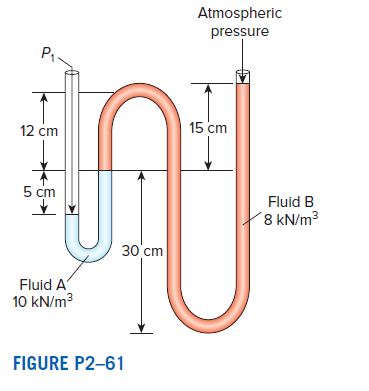
College Physics
11th Edition
ISBN: 9781305952300
Author: Raymond A. Serway, Chris Vuille
Publisher: Cengage Learning
expand_more
expand_more
format_list_bulleted
Concept explainers
Topic Video
Question
Consider the manometer in Fig. P2–61. If the specific
weight of fluid A is 100 kN/m3, what is the absolute pressure,
in kPa, indicated by the manometer when the local atmospheric
pressure is 90 kPa?

Transcribed Image Text:Atmospheric
pressure
12 cm
15 cm
5 cm
Fluid B
8 kN/m3
30 cm
Fluid A
10 kN/m3
FIGURE P2-61
Expert Solution
This question has been solved!
Explore an expertly crafted, step-by-step solution for a thorough understanding of key concepts.
This is a popular solution
Trending nowThis is a popular solution!
Step by stepSolved in 2 steps with 2 images

Knowledge Booster
Learn more about
Need a deep-dive on the concept behind this application? Look no further. Learn more about this topic, physics and related others by exploring similar questions and additional content below.Similar questions
- If the gauge pressure at some depth in the ocean is 3.5 atm, what is the absolute pressure at three times the depth?arrow_forwardThe terminal speed of a spherical partide falling in a liquid is given by where R is the radius of the sphere, e, is its density, p, is the density of the fluid, and n is the coefficient of viscosity. Using this equation, find the viscosity (in mPa · s) of motor oil in which a steel ball of radius 0.9 mm falls with a terminal speed of 4.83 cm/s. The densities of the ball and the oil are 7.86 and 0.88 g/mL, respectively. mPa - sarrow_forwardA bottle with a volume of 181 U. S. fluid gallons is filled at the rate of 1.6 g/min. (Water has a density of 1000 kg/m3, and 1 U.S. fluid gallon = 231 in.3.) How long does the filling take?arrow_forward
- The density of the atmosphere varies drastically with height, but you can use an average density from sea floor to the space in order to calculate its height. If we approximate this average density to be = 1 Kg/m³, what would be height of the atmosphere? HINT: Since the atmosphere is a fluid (in gas form), you can use the hydrostatic pressure formula (P pgh), just solve for h and use P = 1 atm. BTW, this is how the edge of space is defined, if you make it pass the height of the atmosphere you have reached space :)arrow_forwardCalculate the pressure difference, in pascals, between levels C and A, ΔP = PC - PA, for ρ = 0.93×103 kg/m3 and d = 2 cmarrow_forwardThe atmospheric pressure at the sea level is 500,000 N /m ^2 please estimate the total mass (in the unit Kg) of the earths atmospheric above the sea level of an area of 1m^2? Write answer as a whole numberarrow_forward
- The atmospheric pressure on an object decreases as altitude increases. If a is the height (in km) above sea level, then the pressure P(a) (in mmHg) is approximated by P(a)=760e-0.13a. Determine the atmospheric pressure at 7.176 km. Round to the nearest whole unit.arrow_forwardPlease asaparrow_forwardA smoking room is to accommodate 50 smokers. The fresh air requirement for smoking areas is specified to be 40 L/s per person. The air velocity in the ventilation duct is 8 m/s. Determine: b) The diameter of the ventilation duct in [cm] SOLUTIONarrow_forward
- garbage worker tears the arm off a droid. he throws it down a garbage chute and it lands in trash filled with nasty smelly liquids. the overall density is 840kg/m^3. if the arm has a desnity of 5460kg/m^3 and is a cylinder with the volume of 0.0330m^3 what is the buyoncy force in newtons acting on the arm?arrow_forwardA mercury manometer (r = 13,600 kg/m3) is connectedto an air duct to measure the pressure inside. Thedifference in the manometer levels is 15 mm, and the atmosphericpressure is 100 kPa. (a) Judging from Fig. P2–50,determine if the pressure in the duct is above or below theatmospheric pressure. (b) Determine the absolute pressure inthe duct.arrow_forwardWater is discharged from a pipeline at a velocity v given by v=1340*squarerootof p, where p is the pressure in (psi). If the water pressure is changing at a rate of 0.47 psi/second, find the acceleration (dv/dt) of the water when p=20 psi. Round the answer to two decimal places. dv/dt=arrow_forward
arrow_back_ios
SEE MORE QUESTIONS
arrow_forward_ios
Recommended textbooks for you
 College PhysicsPhysicsISBN:9781305952300Author:Raymond A. Serway, Chris VuillePublisher:Cengage Learning
College PhysicsPhysicsISBN:9781305952300Author:Raymond A. Serway, Chris VuillePublisher:Cengage Learning University Physics (14th Edition)PhysicsISBN:9780133969290Author:Hugh D. Young, Roger A. FreedmanPublisher:PEARSON
University Physics (14th Edition)PhysicsISBN:9780133969290Author:Hugh D. Young, Roger A. FreedmanPublisher:PEARSON Introduction To Quantum MechanicsPhysicsISBN:9781107189638Author:Griffiths, David J., Schroeter, Darrell F.Publisher:Cambridge University Press
Introduction To Quantum MechanicsPhysicsISBN:9781107189638Author:Griffiths, David J., Schroeter, Darrell F.Publisher:Cambridge University Press Physics for Scientists and EngineersPhysicsISBN:9781337553278Author:Raymond A. Serway, John W. JewettPublisher:Cengage Learning
Physics for Scientists and EngineersPhysicsISBN:9781337553278Author:Raymond A. Serway, John W. JewettPublisher:Cengage Learning Lecture- Tutorials for Introductory AstronomyPhysicsISBN:9780321820464Author:Edward E. Prather, Tim P. Slater, Jeff P. Adams, Gina BrissendenPublisher:Addison-Wesley
Lecture- Tutorials for Introductory AstronomyPhysicsISBN:9780321820464Author:Edward E. Prather, Tim P. Slater, Jeff P. Adams, Gina BrissendenPublisher:Addison-Wesley College Physics: A Strategic Approach (4th Editio...PhysicsISBN:9780134609034Author:Randall D. Knight (Professor Emeritus), Brian Jones, Stuart FieldPublisher:PEARSON
College Physics: A Strategic Approach (4th Editio...PhysicsISBN:9780134609034Author:Randall D. Knight (Professor Emeritus), Brian Jones, Stuart FieldPublisher:PEARSON

College Physics
Physics
ISBN:9781305952300
Author:Raymond A. Serway, Chris Vuille
Publisher:Cengage Learning

University Physics (14th Edition)
Physics
ISBN:9780133969290
Author:Hugh D. Young, Roger A. Freedman
Publisher:PEARSON

Introduction To Quantum Mechanics
Physics
ISBN:9781107189638
Author:Griffiths, David J., Schroeter, Darrell F.
Publisher:Cambridge University Press

Physics for Scientists and Engineers
Physics
ISBN:9781337553278
Author:Raymond A. Serway, John W. Jewett
Publisher:Cengage Learning

Lecture- Tutorials for Introductory Astronomy
Physics
ISBN:9780321820464
Author:Edward E. Prather, Tim P. Slater, Jeff P. Adams, Gina Brissenden
Publisher:Addison-Wesley

College Physics: A Strategic Approach (4th Editio...
Physics
ISBN:9780134609034
Author:Randall D. Knight (Professor Emeritus), Brian Jones, Stuart Field
Publisher:PEARSON